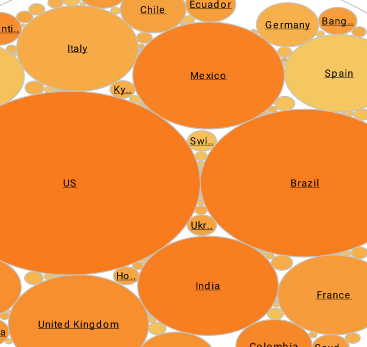| #1 Ranking: Read how InetSoft was rated #1 for user adoption in G2's user survey-based index |
|
Read More |
- Interactivity:
- Data Interactivity: Developers often require the capability to enable interactive features like tooltips, zooming, and panning for users to explore and understand the data better.
- Event Handling: The ability to handle user interactions like clicks and hovers is essential for creating dynamic and responsive applications.
- Real-Time Data Support:
- Streaming: For applications dealing with real-time data, the chart tool should support streaming data to provide up-to-the-minute visualizations.
- Scalability:
- Performance: The chart tool should be able to handle large datasets efficiently, ensuring smooth performance even with extensive amounts of data.
- Integration:
- APIs and Libraries: Seamless integration with common programming languages and frameworks (JavaScript, Python, etc.) is vital. Having well-documented APIs and libraries simplifies the development process.
- Data Source Connectivity: The ability to connect to various data sources (databases, APIs, etc.) facilitates easy data retrieval for visualization.
- Responsive Design:
- Mobile Compatibility: As applications are accessed on various devices, including mobile, the chart tool should support responsive design to ensure optimal viewing and interaction across different screen sizes.
- Security:
- Data Encryption: If the application deals with sensitive data, the chart tool should support data encryption to ensure the security of information during transmission and storage.
- Collaboration Features:
- Sharing and Embedding: The capability to share charts easily and embed them in other applications or websites promotes collaboration and data dissemination.
- Accessibility:
- ADA Compliance: A good chart tool should adhere to accessibility standards to ensure that charts are usable by individuals with disabilities.
- Documentation and Support:
- Comprehensive Documentation: Clear and comprehensive documentation is crucial for developers to quickly understand and implement the chart tool's features.
- Community Support: An active and supportive user community can be valuable for addressing issues and sharing best practices.
This is from the API documentation of Style Intelligence, InetSoft's business intelligence software for dashboards, reporting, and analytics. Other chart tools are Style Scope Enterprise Edition, the stand-alone dashboard software product and the free web-based Visualize Free.
LineElement.setClosed(boolean)
Specifies whether the line object should be automatically closed (i.e., endpoints connected).
Type
Boolean
true: close the figure
false: do not close
Example (Report or Viewsheet)
importPackage(inetsoft.graph)
importPackage(inetsoft.graph.data)
importPackage(inetsoft.graph.scale)
importPackage(inetsoft.graph.aesthetic)
importPackage(inetsoft.graph.element)
var arr = [["State","Quantity"], ["NJ",100], ["NY",300],
["PA",200]];
dataset = new DefaultDataSet(arr);
graph = new EGraph();
elem = new LineElement("State", "Quantity")
elem.setClosed(true);
graph.addElement(elem);
 |
“Flexible product with great training and support. The product has been very useful for quickly creating dashboards and data views. Support and training has always been available to us and quick to respond.
- George R, Information Technology Specialist at Sonepar USA
|
LineElement.setEndArrow(boolean)
Specifies whether an arrow should be drawn at the end of the line (last point).
Parameters
Boolean
true: draw arrow
false: do not draw arrow
Example (Report or Viewsheet)
importPackage(inetsoft.graph)
importPackage(inetsoft.graph.data)
importPackage(inetsoft.graph.scale)
importPackage(inetsoft.graph.aesthetic)
importPackage(inetsoft.graph.element)
var arr = [["State","Quantity"], ["NJ",100], ["NY",300],
["PA",200]];
dataset = new DefaultDataSet(arr);
graph = new EGraph();
elem = new LineElement("State", "Quantity")
elem.setEndArrow(true);
graph.addElement(elem);
 |
“We evaluated many reporting vendors and were most impressed at the speed with which the proof of concept could be developed. We found InetSoft to be the best option to meet our business requirements and integrate with our own technology.”
- John White, Senior Director, Information Technology at Livingston International |
LineElement.setStackGroup(boolean)
Specifies whether each subgroup receives an independent element (separate line), or whether a single element is used for all.
Parameters
Boolean
true: independent lines for each group
false: single line for all groups (default)
Example (Report or Viewsheet)
importPackage(inetsoft.graph)
importPackage(inetsoft.graph.data)
importPackage(inetsoft.graph.scale)
importPackage(inetsoft.graph.aesthetic)
importPackage(inetsoft.graph.element)
var arr = [["State","Product","Quantity"], ["NJ","P1",200],
["NJ","P2",300], ["NY","P1",300],
["NY","P2",100]];
dataset = new DefaultDataSet(arr);
graph = new EGraph();
var elem = new LineElement("State", "Quantity");
elem.setColorFrame(new CategoricalColorFrame("Product"));
elem.setStackGroup(true);
graph.addElement(elem);
LineElement.setStackNegative(Boolean)
Specifies whether negative and positive values stack independently on opposite sides of the axis, or whether stacking is cumulative (i.e., determined arithmetically).
Parameters
Boolean
true: independent stack order for each group
false: single stack order for all groups
Example (Report or Viewsheet)
importPackage(inetsoft.graph)
importPackage(inetsoft.graph.data)
importPackage(inetsoft.graph.scale)
importPackage(inetsoft.graph.aesthetic)
importPackage(inetsoft.graph.element)
var arr = [["State","Product","Quantity"], ["NJ","P1",200],
["NJ","P2",300], ["NY","P1",-300],
["NY","P2",100]];
dataset = new DefaultDataSet(arr);
graph = new EGraph();
var elem = new LineElement("State", "Quantity");
var scale = new LinearScale("Quantity");
elem.setColorFrame(new CategoricalColorFrame("Product"));
elem.setStackGroup(true);
elem.setStackNegative(false);
elem.setCollisionModifier(GraphElement.STACK_SYMMETRIC);
graph.addElement(elem);